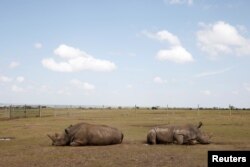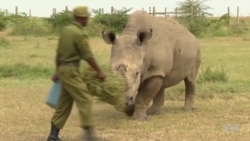The world’s last male white northern rhino has died in Kenya. Conservationists say his death underscores the urgent need to end illegal trade in rhino horn.
The northern white rhino once roamed Africa in the hundreds, some say even in the thousands.
The population is now down to two, with the species at risk of extinction.
The last male northern white rhino, named Sudan, died Monday at the Ol Pejeta Conservancy in Kenya. He is survived by two females, his daughter Najin and his granddaughter Fatu.
Elodie Sampere is a manager at the Ol Pejeta Conservancy. She spoke to VOA.
“He was suffering from old-age conditions, such as arthritis and lack of mobility in his legs," Sampere said. "He was losing mobility in his legs, and we were treating him for all these things, and then it just got the best of him, and then on Sunday, he was unable to get up any more, and you know once a rhino is unable to get up, that means he is unable to feed. So the decision was made to euthanize him, but in the end it was because his legs gave up on him."
Sampere says there is hope of preserving the species.
“They retrieved some of the genetic material yesterday after he was dead. There was also some semen stored from Sudan, so we have some stored semen," Sampere said. "The death of Sudan does not mean the death of the species. We still have two females that are there, and there are plans to do OPU later this year, which basically means that we are going to retrieve the egg from the females in the hope of creating embryos, so his death does not mean the end of the species.”
She says the plan is to use a southern white rhino as a surrogate. Both Najin and Fatu suffer from medical conditions that prevent them from carrying pregnancies.
Sudan's death comes amid efforts curb rhino poaching. The London-based charity Save the Rhino says that in just a decade, more than 7,000 rhinos have been killed for their horns in Africa.
All international trade in rhino horn is outlawed. However, consumer demand in Asia continues to fuel a black market.
WATCH: Once the World’s ‘Most Eligible Bachelor’ and Only White Rhino Dies
Ol Pejeta Conservancy says Sudan’s death is a wake-up call.
“If we as human beings are allowing the second biggest mammal in the planet to go extinct, what does it mean for the bees and the frogs and every little organism in this planet? It means they have no chance. If this is not a wake-up call for the rest of the world, if this is not a wake-up call for Kenya, then we are doomed," Sampere said.
In addition to his ailments in old age, loneliness may have marked Sudan's final days at Ol Pejeta Conservancy. The only other male of his species, Suni, had died in 2014. Sudan spent his final years surrounded by armed guards who watched over him day and night to protect him from poachers.









